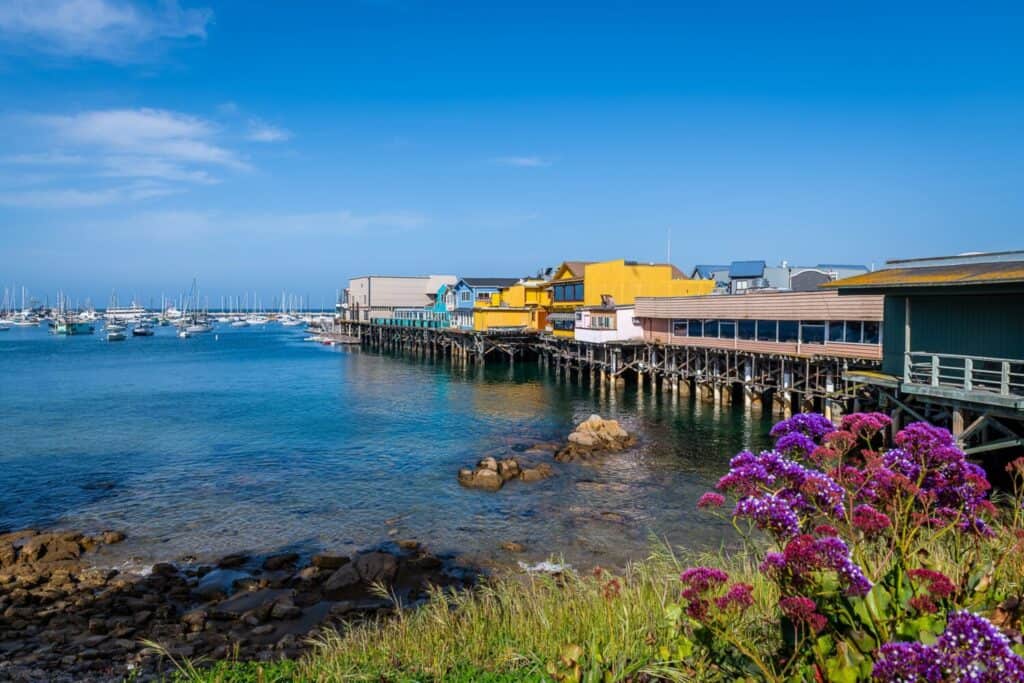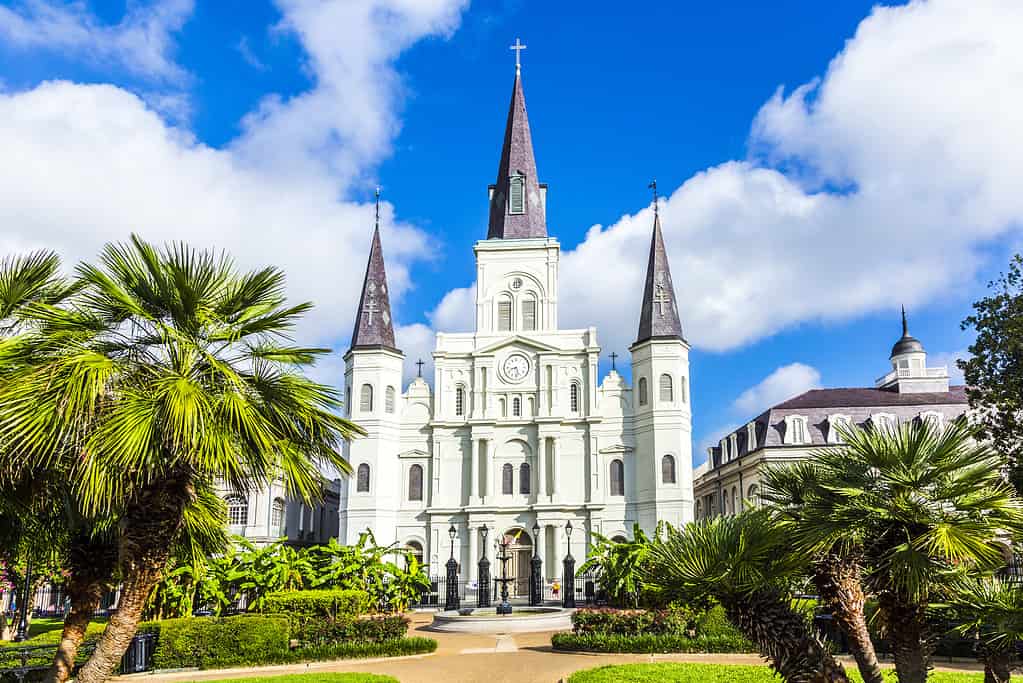The oldest church in California has several more national and statewide superlatives. It’s also the oldest continuously operating parish in California. The oldest stone building in California. The parish that has been in continuous operation the longest. And it’s tied for the oldest — and smallest — serving cathedral in America. What we’re trying to tell you is, this church is old!
The building was completed in 1794 and has seen a fascinating era of Spanish, Mexican, and, eventually, United States history. Maybe even more amazing, the Cathedral of San Carlos Borromeo is still standing and operating. Let’s discover the amazing tale of the oldest church in California.
The Monterey Presidio: Home to the Oldest Church in California
Located in the Southern California town of Monterey, Catedral de San Carlos Borromeo is the only presidio chapel in California. Both the chapel and the presidio are still in active operation to this day. Presidio is a word meaning “fort” or “garrison”. Sure enough, the Monterey Presidio is in active use by the US military. In fact, it’s the only presidio left in California that has an active military installation.
Amazingly, this fortress’ history dates all the way back to 1602. That’s almost 100 years before pilgrims would land on Plymouth Rock, and almost 200 years before the American Revolution. This was the era of the Spanish Empire, and the fort remained under Spanish control until the Mexican-American War. In 1846, the US Navy seized control of Monterey from Spain. Fast forward to today: the Monterey Presidio is home to the US Military’s Defense Language Institute Foreign Language Center (or DLI-FLC).
History of the Monterey Peninsula and Monterey Presidio
The history of the Monterey Presidio goes all the way back to 1602. That’s when a Spanish soldier and entrepreneur known as Sebastian Vizcaino discovered a place he would name the Monterey Peninsula. He was not the first to discover it by any means; Indigenous people had lived here since before recorded history. Nevertheless, Vizcaino claimed the peninsula for Spain. The name “Monterey Peninsula” derives from Vizcaino’s benefactor, Count Gaspar de Zuniga y Acevedo, Viceroy of New Spain, and the Count of Monterrey (the one in Spain).
For nearly two centuries, there was little activity on the peninsula. In the 1770s, the Spanish Empire decided it would be prudent to turn Monterey Peninsula into a fortress — a presidio.

The history of the Monterey Presidio goes all the way back to 1602. That’s when a Spanish soldier discovered a place he would name the Monterey Peninsula.
©Chris LaBasco/Shutterstock.com
History of San Carlos Borromeo, the Oldest Church in California
The Cathedral of San Carlos Borromeo was first founded in 1770 near a Native village known as Tamo. It was founded by Junípero Serra, a Franciscan friar who would eventually go on to be sainted. San Carlos Borromeo was initially classified as a mission — a headquarters for missionaries, whose duties were to attempt to convert people to their faith. The history of Borromeo begins unhappily. It seems that as soon as Serra got the Spanish government to agree to build his mission here, they decided to make it a military base, as well. Almost immediately, these dual purposes became cross-purposes.
Military Governor Pedro Fages was sent to Monterey with troops to oversee the construction of the mission building. Fages treated his soldiers tyrannically as they constructed the wood-and-adobe building. He would force them to work during hurricanes; harshly punishing anyone caught resting. Worse still, he turned a blind eye when his soldiers would violently attack the nearby Native population.
History of San Carlos Borromeo: From Mission to Chapel
Serra began to hear of these atrocities and as a man of God protested to Fages. A power struggle ensued that ultimately saw Serra relocate his mission. By 1771, the Spanish viceroy had approved Serra’s petition, and the mission moved to what is now Carmel-by-the-Sea, California. Serra’s mission still operates there.
Fage’s dastardliness notwithstanding, his Presidio still needed a church. So the chapel he had been building for Serra’s mission instead became the San Jose Chapel for the Presidio of Monterey. In 1777, the Spanish government declared Monterey the new capital of the Province of Californias. This is when the chapel got its third name: the Royal Presidio Chapel.
In 1789, the chapel burned down in an accidental blaze caused by gunfire. Between 1791 and 1795, it was rebuilt — this time in sandstone. This is the structure that still stands today.
Jump ahead half a century to 1840: this is when the chapel got yet another new name when it was rededicated to Saint Charles Borromeo.
Now, jump ahead 120 years: the US National Park Service designates San Carlos Borromeo a National Historic Landmark on the National Register of Historic Places.

Located in the Southern California town of Monterey,
Catedral de San Carlos Borromeois the only presidio chapel in California.
©rruntsch/iStock via Getty Images
The Oldest Cathedral in California — and Tied for Oldest in America!
It’s worth mentioning that Borromeo shares the record for the oldest serving cathedral in the US. St. Louis Cathedral in New Orleans, Louisiana was built in the same year — 1794.
St. Louis Cathedral has a fascinating history all its own. Where San Carlos Borromeo was built by the Spanish Empire, St. Louis Cathedral was dedicated to a king of France — King Louis IX, to be precise. Just like San Carlos, St. Louis Cathedral burned down and had to be rebuilt, in the exact same year.
Where Borromeo’s architecture shows Spanish and Moorish influences, the treble spires and symmetrical facade of St. Louis Cathedral display the Renaissance and Gothic Revival architectural styles more closely associated with France. Opening onto a pedestrian plaza in the heart of New Orleans’ French Quarter, foregrounded by a statue of controversial President Andrew Jackson, it’s fair to say this cathedral is a more iconic representation of its home city than the somewhat less visually familiar San Carlos Borromeo.
St. Louis Cathedral may appear in more paintings, photographs, television and film than Borromeo. But historians call the Monterey Presidio housing the cathedral the most historically important site on the entire West Coast.

St. Louis Cathedral in New Orleans, Louisiana was built in the same year as the Cathedral of San Carlos Borromeo — 1794.
©Meinzahn/iStock via Getty Images
Architecture of San Carlos Borromeo
The first stone building in California, San Carlos Borromeo was built in the Spanish Colonial style. Experts say its ornamental carved portals and arches also reflect the influence of Moorish architecture. A distinctive statue of The Lady of Guadalupe tops the cathedral’s facade. This is the oldest non-indigenous sculpture in California. Behind the statue is a bell tower that announces daily mass. The mission is surrounded by a garden, with paths leading to the nearby school and rectory (the housing provided for the priest). Nearby the cathedral, a statue of the Virgin Mary can be found. And behind the building is a California landmark, the Vizcaino Oak.
Modern-Day Restoration of San Carlos Borromeo
After a Historic Structure Report was completed on San Carlos Borromeo in 1999, various organizations set to work raising money to preserve this cathedral for future generations. Restoration began in May of 2007. Funding was raised from private donations, the California Missions Foundation, the Getty Foundation, the Monterey County Community Foundation, and the Walker Foundation.
A drainage system was implemented to keep water from eroding the sandstone, and certain elements of the building were carefully removed so that the whole structure could be moisture-proofed. The roof was removed and its resident termites exterminated, and a retrofitted attic was installed.
Restoration experts removed a layer of plaster that covered the original stone walls. They found them extraordinarily well-preserved given that they began life back in 1794. They also found it to have a great deal more decoration than they were expecting! By contrast, 100 tons of stone and lime mortar were required to replace and reinforce the part of the cathedral built in 1858 — 80% of it had to go.
Finally, to strengthen San Carlos Borromeo against potential earthquakes, the whole structure was seismically retrofitted. Steel bars were drilled through the walls, “tying” them together.
Visiting San Carlos Borromeo
The Cathedral of San Carlos Borromeo continues to be an operating church in the central part of the City of Monterey. This means you can visit and observe or take part in Catholic Masses or sermons, in both English and Spanish. You can also tour the interior during non-ceremony times. Aside from the architecture discussed above, the cathedral is noted for its soaring nave, sunlit windows, and oil paintings of biblical scenes.
Continue on to the Heritage Center Museum. Here, you can take a docent-guided tour of the church and grounds. See if you can find the preserved remains of the Vizcaíno-Serra oak tree, here since the early 1600s at least. You can take the garden path to the giant oak-lined San Carlos Cemetery. It’s replete with centuries’ worth of buried souls and fascinating historical headstones and statuary.
Note that the museum is closed on Tuesdays and Thursdays. Though you can visit for free, the church accepts donations.
If you’re interested in the intertwined histories of the fortress and the cathedral, there is also the Presidio of Monterey Museum right nearby, in Lower Presidio Historic Park. (This one’s also free of charge, and a less frequently visited location if you’re looking for a more tranquil experience.)
Some have called the Presidio the most important historical site on the entire West Coast. Here, you can learn even more about the amazing cultural history of this ancient location, starting with Indigenous life as it was before colonizers arrived.
The museum will take you from that point, through the Spanish empire period, on to its Mexican history, through its falling into American hands, and up to the present day, with a focus on military history and customs. Fantastic panoramic views of the bay are an added bonus.
Wildlife Around San Carlos Borromeo
Centrally located as San Carlos Borromeo is, the wildlife you’re most likely to see is the usual: squirrels, pigeons, seagulls. But you are right on Monterey Bay, which is such a hotbed of marine wildlife that it’s sometimes called “the Serengeti of the Sea”! The area provides loads of options for getting to the beach, onto or into the ocean.
You should have no trouble making the acquaintance of a vast range of marine life: dolphins, otters, whales, seals, and sea lions, as well as more fish and birds than can be numbered here. Your best bet for one-stop shopping might be the Monterey Bay National Marine Sanctuary (MBNMS), a federally protected area of the California Central Coast. The sanctuary covers 276 miles of coast between the cities of Marin and Cambria and extends 30 miles into the ocean. (That’s bigger than Yellowstone!)
Within MBNMS can be found huge kelp forests, an even larger underwater canyon, and over 740 species of animal, including marine mammals, fish, invertebrates, algae, and birds. The landscape is diverse, too, encompassing sandy dunes, rocky cliffs, steep mountains, and secluded estuaries.
Its purposes are education, research, species protection, and public use. That’s right: even with its protections, you can dive, boat, surf, kayak, and whale watch here! The sanctuary’s programs and visitor centers provide many experiences that help you get up close to the animals, and a number of private contractors, such as whale watching or seal sighting, can be hired to give you the optimal experience.
The photo featured at the top of this post is © Robert Campbell / CC BY-SA 3.0 – License / Original
Thank you for reading! Have some feedback for us? Contact the AZ Animals editorial team.






